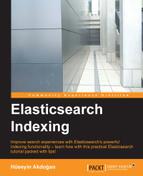The world that we live in is hungry for speed, efficiency, and accuracy. We want quick results and faster without compromising the accuracy. This is exactly why I have written this book. I have penned down my years of experience in this book to give you an insight into how to use Elasticsearch more efficiently in today's big data world. This book is targeted at experienced developers who have used Elasticsearch before and want to extend their knowledge about how to effectively perform Elasticsearch indexing. While reading this book, you'll explore different topics, all of which connect to efficient indexing and relevant search results in Elasticsearch. We will focus on understanding the document storage strategy and analysis process in Elasticsearch. This book will help you understand what is going on behind the scenes when you send a document for indexing or make a query. In addition, this book will ensure correct understanding of the meaning of schemaless by asking the question—is the claim that Elasticsearch stands for the schema-free model always true? After this, you will learn the analysis process and about analyzers. More importantly, this book will elaborate the relationship between data analysis and relevant search results. By the end of this book, I believe you will be in a position to master and unleash this beast of a technology.
Chapter 1, Introduction to Efficient Indexing, will introduce you to the document storage strategy and the basic concepts related to the analysis process.
Chapter 2, What is an Elasticsearch Index, describes the concept of Elasticsearch Index, how the inverted index mechanism works, why you should use data denormalization, and what its benefits. In addition to this, it explains dynamic mapping and index flexibility.
Chapter 3, Basic Concepts of Mapping, describes the basic concepts and definitions of mapping. It answers the question what is the relationship between mapping and relevant search results questions. It explains the meaning of schemaless. It also covers metadata fields and data types.
Chapter 4, Analysis and Analyzers, describes analyzers and the analysis process of Elasticsearch, what tokenizers, the character and token filters, how to configure a custom analyzer and what text normalization is. This chapter also describes the relationship between data analysis and relevant search results.
Chapter 5, Anatomy of an Elasticsearch Cluster, covers techniques to choose the right number of shards and replicas and describes a node, the shard concept, replicas, and how shard allocation works. It also explains the architecture of data distribution.
Chapter 6, Improving Indexing Performance, covers how to configure memory, how JVM garbage collector works, why garbage collector is so important for performance, and how to start tuning garbage collector. It also describes how to control the amount of I/O operations that Elasticsearch uses for segment merging and to store modules.
Chapter 7, Snapshot and Restore, covers the Elasticsearch snapshot and restore module, how to define a snapshot repository, different repository types, the process of snapshot and restore, and how to configure them. It also describes how the snapshot process works.
Chapter 8, Improving the User Search Experience, introduces Elasticsearch suggesters, which allow us to correct spelling mistakes and build efficient autocomplete mechanisms. It also covers how to improve query relevance by using different Elasticsearch functionalities such as boosting and synonyms.
